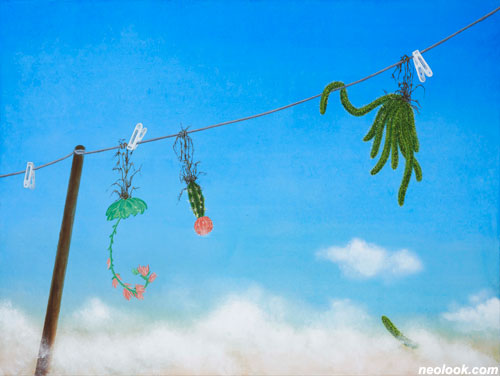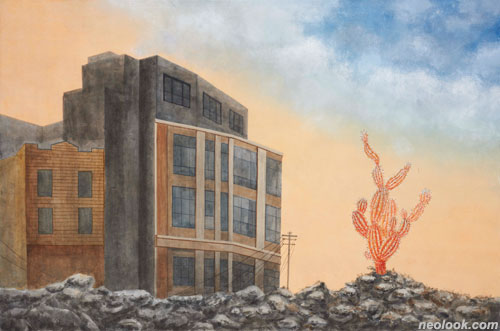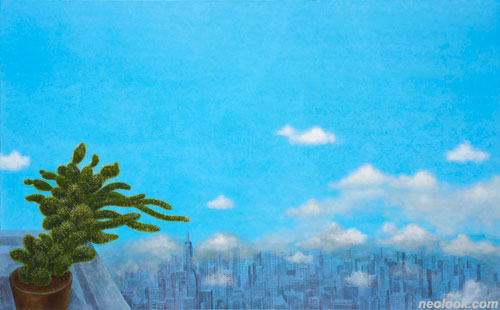- ● homepage
- ● archives
- ● restoration
- ● books
- ● big banners
- ● post board
- ■ neo's search
- ■ about us
- ■ 게재방법 안내
- 개인정보처리방침

- [email protected]
- Tel. 02_335_7922
- Fax. 02_335_7929
- 10:00am~04:30pm
- 월요일~금요일
- 3/3(월) 대체공휴일

Paradise of Loneliness
장유정展 / JANGYOUJUNG / 張裕政 / painting 2012_1026 ▶ 2012_1104
● 위 이미지를 클릭하면 장유정 블로그로 갑니다.
별도의 초대일시가 없습니다.
관람시간 / 10:30am~06:30pm
갤러리 한옥 GALLERY HANOK 서울 종로구 가회동 30-10번지 Tel. +82.2.3673.3426 galleryhanok.blog.me
외로움의 낙원, 혹은 장유정의 회화 ● 장유정 회화의 미적 기호는 간결하지만 제법 뚜렷하다. 도시와 선인장. 서로 어울리지 않을 것 같은 두 기호가 '낯설게' 긴장하며 하나의 화면에서 양립하고 있다. 저 대칭적인 두 기호가 이끄는 대로 순순히 따라가다 보면 어느 순간, 작가가 자신의 작품에서 말하고자 하는 의미, 즉 작가가 조용히 속삭이는 내면의 목소리를 들을 수 있을 것이다. 작가의 내면을 엿보기 전에, 잠시 엉뚱한 상상을 하나 해보자. '만약에' 인류가 여전히 수렵과 채집을 하며 살고 있다면, 그러니까 인류가 아직도 물고기를 잡고, 나무 열매를 따고, 이 숲 저 산에서 산짐승을 사냥하며 살고 있다면, 그래도 도시는 존재했을까? 존재했다면 그 모습은 어떠했을까? 결론부터 말하면, 도시는 존재할 수 없었다. 단순화의 위험을 무릅쓰고 말하자면 수렵과 채집은 자연에 순응하는 삶의 양식이었으므로 정착은 할 수도 없었고 할 필요도 없었다.

- 장유정_Paradise of Loneliness_한지에 채색_73×182cm_2012

- 장유정_stunt flying_한지에 채색_65×91cm_2012
도시는, 인류가 스스로를 자연에서 추방하는 순간, 다시 말해 유목과 수렵 대신 농경과 정착을 선택하는 순간, 이미 잉태되고 있었다. 그리고, 농경을 버리고 산업화를 선택하는 순간, 도시는 폭발하듯 성장해 세계 곳곳에 메트로시티를 만들어 놓았다. "도시는 고독이 모여 만든 공간이다." 러시아 근대 문학의 봉우리 가운데 하나인 레오니드 니콜라이비치 안드레프가 한 말이다. 산업혁명 이후 인류는 삶의 자궁인 자연을 통째로 버렸다. 그로부터 200년 후, 혹은 100년 후 인류는 자연을 떠나며 잃은 것보다 몇 배는 더 많은 것을 얻었다. 도시, 기계, 자본, 물질, 풍요 그리고 갈등과 소외와 외로움...

- 장유정_Paradise of Loneliness_한지에 채색_100×60cm_2012
장유정의 회화 풍경 안에는 인간이 부재하지만 그러나 사실은 틀림없이 인간이 존재한다. 도시가 '세계' 또는 '타자'를 상징한다면 선인장은 '자아'를 의미한다고 볼 수 있다. 도시 저 반대편에 있는 자연, 수렵 대신 농경과 산업화를 선택한 인류가 사실은 제법 오랜 시간 외면한 '그 자연'으로 해석해도 무방할 테지만, 그의 도시 풍경 속에서 선인장은 아무래도 '자아'를 의미한다고 보는 게 더 효과적인 독해로 보인다. 다시 선인장으로 시선을 돌려보자. 선인장이 애리조나의 어느 사막이나 고산지대에 존재한다면 그것은 위에서 이야기한 자연의 일부이다. 열정이라는 꽃말을 가진 나무이고, 날카로운 가시가 달린 식물일 뿐이다. 하지만 작가가 원산지가 아메리카인 저 식물을 작품 안으로 끌어들이는 순간, 선인장은 회화적 기호로 치환된다. 도시가 작가를 둘러싼 '세계'라면 선인장은 세계에 둘러싸인 작가 자신, 즉 '자아'이다.

- 장유정_Flying_한지에 채색_61×73cm_2012
회화는 경험 또는 기억을 뿌리삼고, 여기에 작가가 내적 반응을 섞고 융합하여 창조한 시각 언어이다. 회화의 힘이자 특징은 가시화, 즉 볼 수 없는 것을 보여주는 (혹은 보이게 해주는) 데 있다. 마찬가지로 장유정의 회화는 어느 풍경을 재현한 것이 아니라(생각해보라. 도시의 시멘트 바닥을 뚫고 나오는 선인장을 본 적이 있는가? 창가에서 서성이는, 혹은 빨랫줄에 매달려 시들어가는 선인장을 실제로 본적이 있는가?) 그가 해석한 '세계'와 그 세계에서 자존하는 '자아'를 도시와 선인장으로 은유하여 보여주고 있다. ● 한 세기 전 안드레프가 근대 시민의 고독을 말했다면 장유정은 외로움을 보여준다. 작가는 보이지 않는, 그러나 분명히 존재하는 외로움을 가시화하고, 외로움을 그만의 방식으로 의미화한다. 롤랑 바르트 식으로 말하면 외로움은 '부재'에서 오는 것이다. 존재하지 않은 그 무엇 때문에 인간은 운명적으로 우울을 가슴에 품고 산다. 장유정이 보여주는 외로움은 그러나, 타자와 '불화하는' 외로움이 아니다. 그가 회화에서 의미화하는 것은 오히려 사유의 외로움이고, 모색의 칠정이다. 장유정이 가시화하는 것은 그러므로 생기와 가능성을 품은 따뜻하고 즐거운 고독이다. ■ 유명종

- 장유정_Paradise of Loneliness_한지에 채색_61×91cm_2012

- 장유정_Paradise of Loneliness_한지에 채색_61×91cm_2012
Paradise of Loneliness, You-jung Jang's Painting ● Aesthetic symbols in You-jung Jang's painting are concise, yet quite clear. A city and cactus are two symbols which do not appear to go together, co-exist in a screen, in an "unfamiliar" way in tension. While you follow those two contrasting symbols obediently, at some point you discover meanings the artist wanted to convey, or listen to inner voice, whispered quietly by him. ● Before peeing into the artist's inside, let's indulge in a wild-eyed imagination for a moment. 'What if', the humankind is still hunting and gathering for living, that is, what if we are still catching fish, collecting fruits or hunting for wild animals from forest to forest, would a city still exist? If it did exist indeed, how would it have looked like? In short, a city could not exist. If I were to say, risking the danger of simplification, hunting and gathering was a way of life, adapting to nature and people could not settle or indeed, there was no need for them to do so. ● A city was conceived the moment the mankind exiled itself from the nature voluntary, or chose agriculture and settlement instead of nomadic life and hunting. Moreover, the moment people opted to abandon agriculture and choose industrialization, cities grew out in explosion, establishing metro cities throughout the world "A city is the place where solitude gathered and created", according to Leonid Nikolayevich Andreyev, one of the cornerstones of contemporary Russian literature. Since the industrial Revolution, the mankind has completely abandoned life's womb, nature. Since then, after two decades, or one decade later, the mankind gained a lot more, many times more than what it lost by leaving nature, such as cities, machines, capital, materials, affluence as well as conflicts, isolation and loneliness. ● No humans are present in the scenes of You-jung Jang's painting, but the truth is, humans are in the painting. If the city symbolizes 'the world" or "others it is safety to say that cactus symbolizes 'self'. The mankind chose cities instead of nature, on the other side of the city and agriculture and industrialization instead of hunting and gathering. ● It would not be too far off to interpret nature as 'that nature' which the mankind has neglected for quite long time. However, it would be an effective interpretation that the cactus in his urban scenes, symbolizes 'self'. Let's avert our attention to cactus again. If the cactus exists in some desert in Arizona or lofty mountains, it is a part of above-mentioned nature. It is a tree with the language of flowers called passion and the plants with sharp thorns. ● However, the moment the artist brings in the plant native from America, the cactus is substituted as the symbol in a painting. If the city is the 'world' which surrounds the artist, the cactus is the artist himself, surrounded by the world, or 'self'. The painting has its roots in experiences or memories. Here, the artist mixes in and fuses his inner reactions and creates the painting as the visual language. Visualization, the strength and characteristic of the paintings, shows those that cannot be seen (or allowing them to be seen). Likewise, the painting by You-jung Jang is not the reproduction of certain scenery but, (Think about it. Have you ever seen cactus that penetrates the cement and grows in the city? Have you ever seen the cactus, hovering in the window or hung on the clothesline and withering?) He interprets metaphorically the 'world' he has interpreted and 'self' that co-exists in the world using a city and cactus. ● While a century ago, Andreyev talked of the isolation of contemporary people, You-jung Jang shows loneliness. The artist visualizes loneliness that is not seen but apparently exists and symbolizes loneliness in a way that is unique to him. In the words of Roland Barthes, loneliness comes from 'absence'. Because of something that does not exist, humans embrace melancholy as fate. Loneliness You-jung Jang shows, however, is not loneliness that comes from experiencing 'discord' with others. What he represents in his painting is rather, loneliness with reason and seven passions he seeks. What he visualizes is solitude, warm and pleasant with liveliness and possibilities. ■ Myong Jong Yoo
Vol.20121026b | 장유정展 / JANGYOUJUNG / 張裕政 / painting

